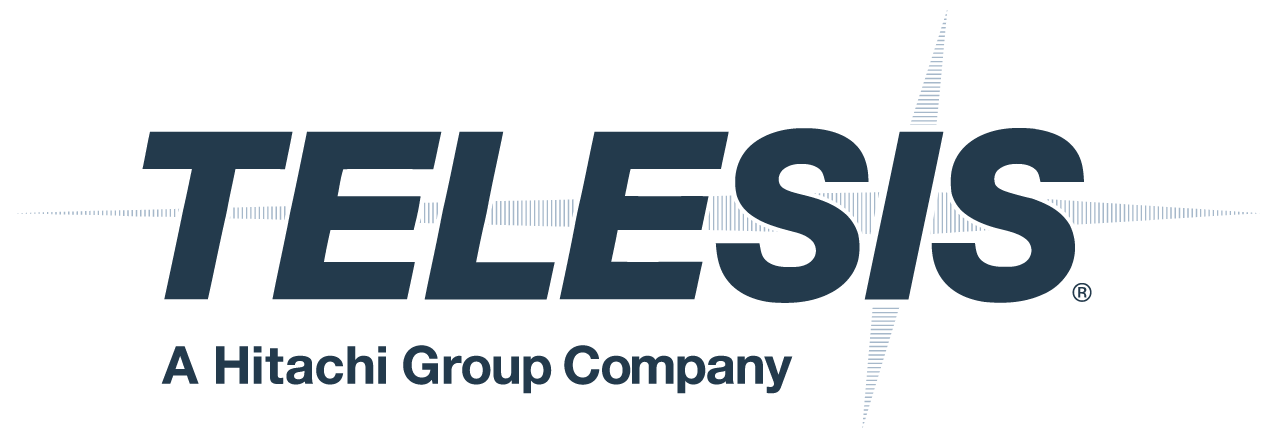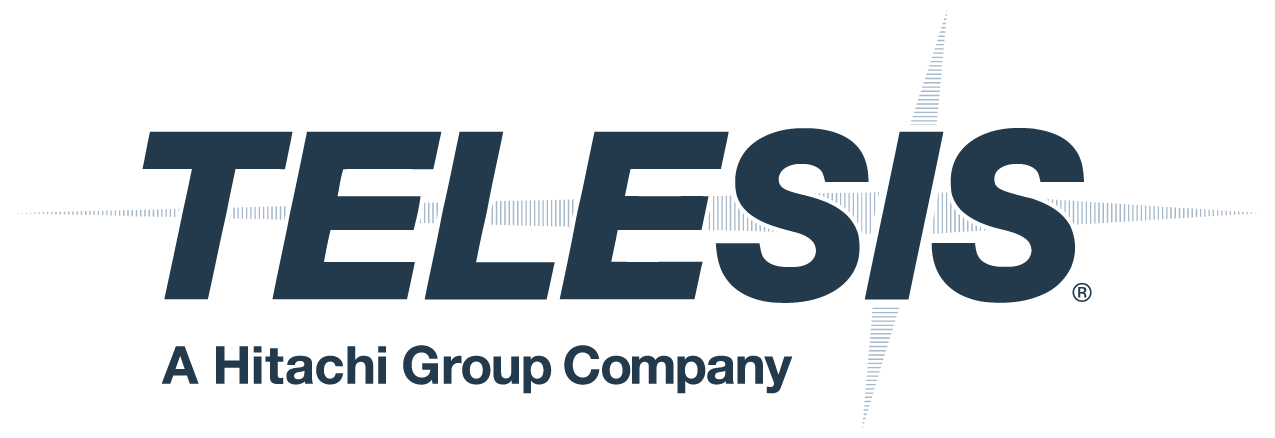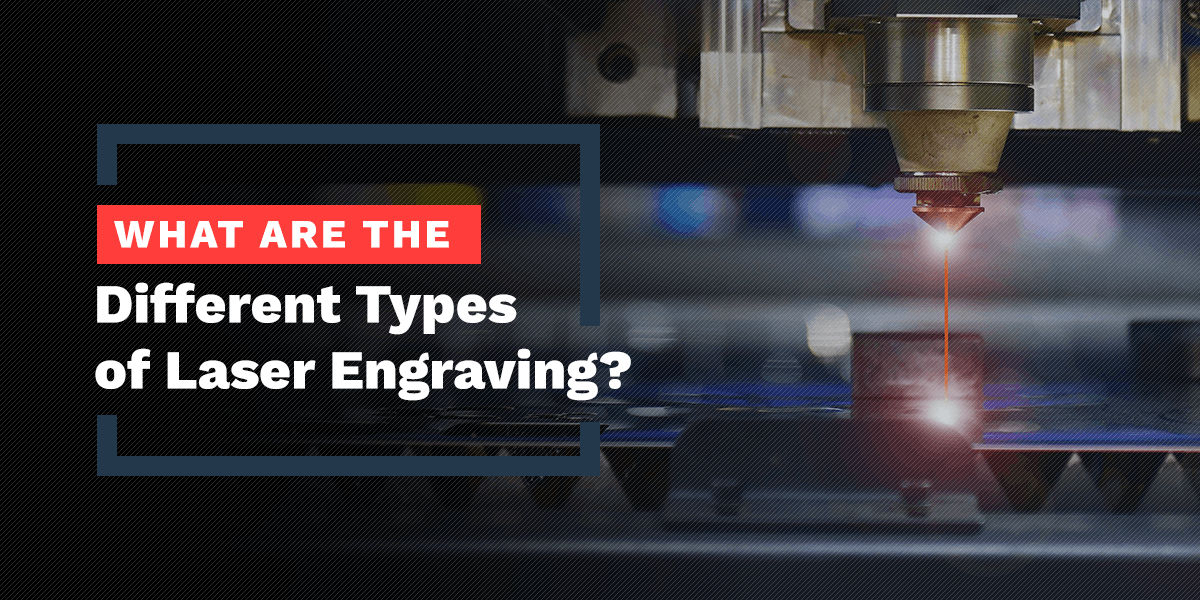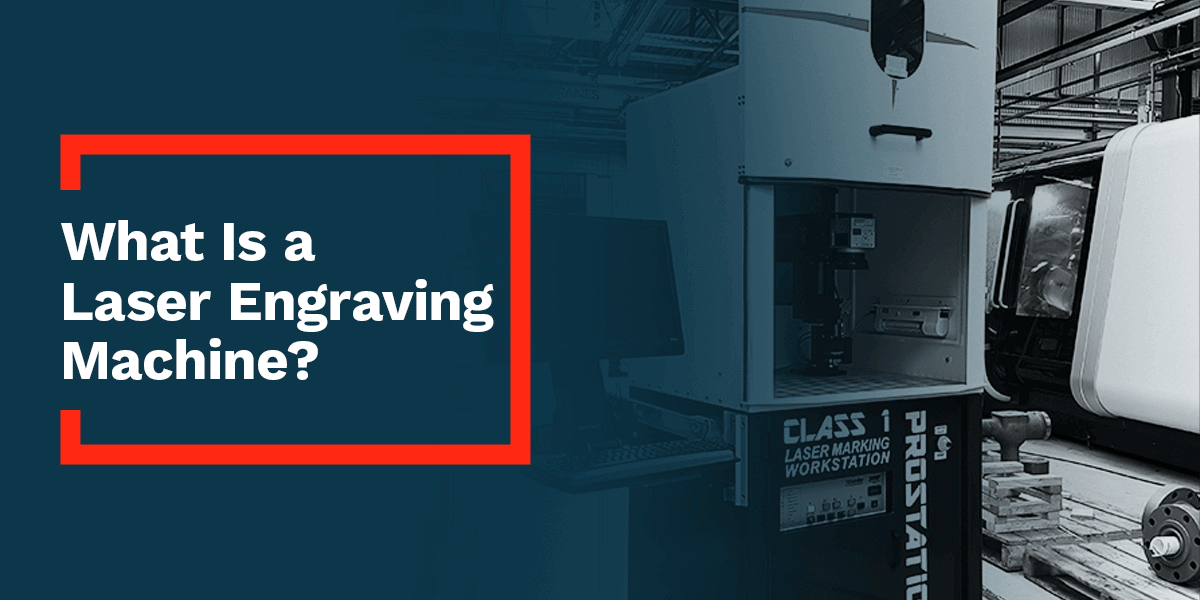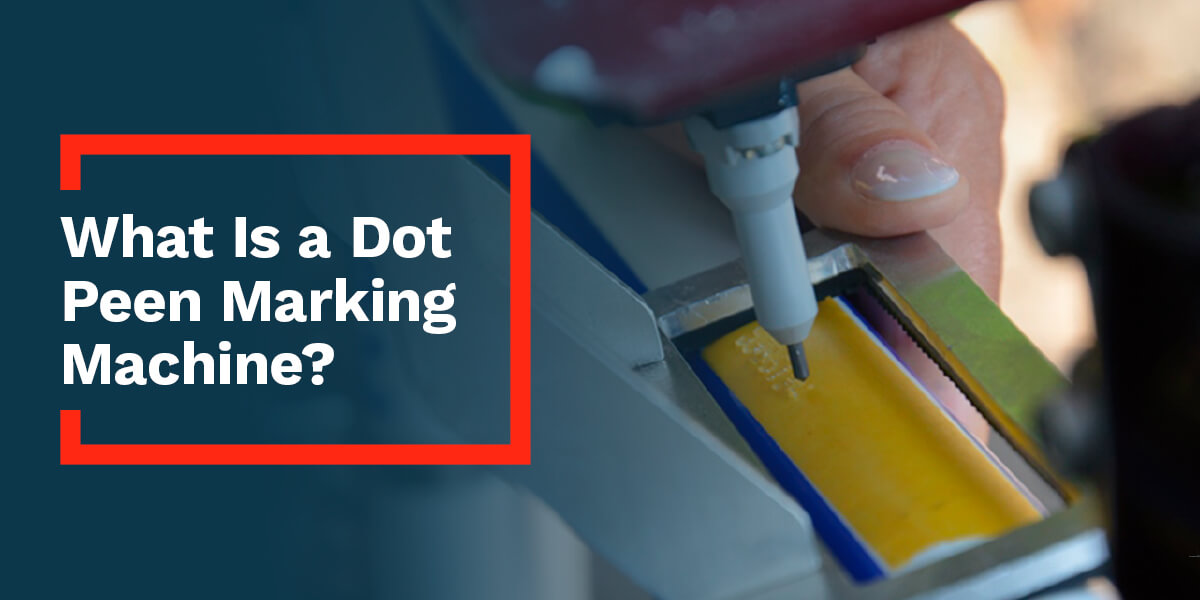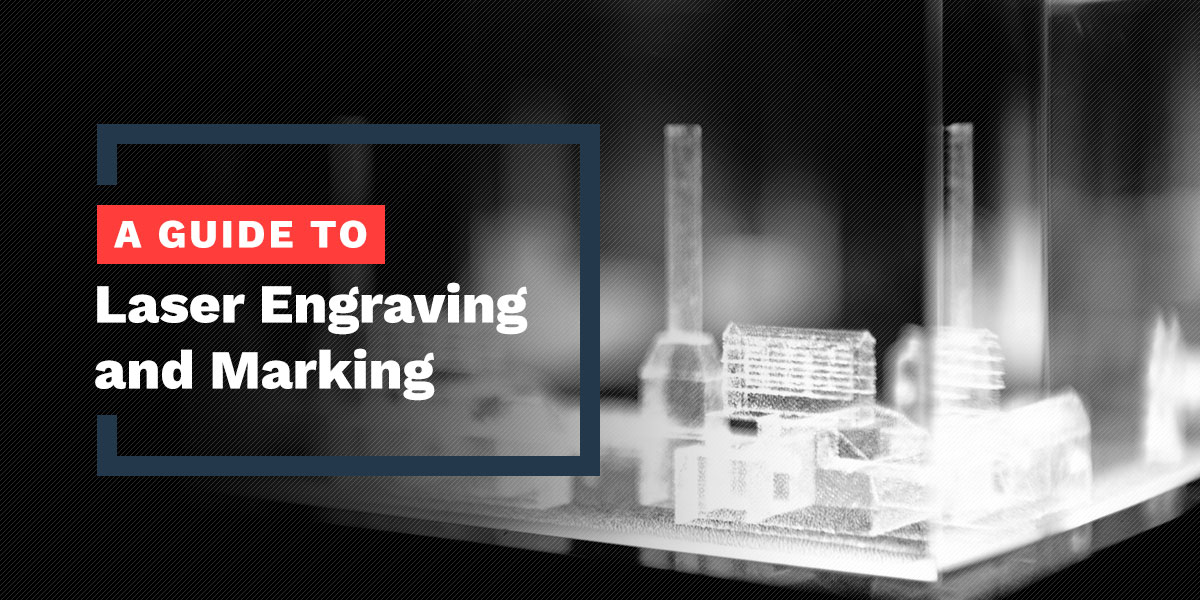
22 Apr What is Laser Marking?
Jump To:
A Guide to Laser Engraving and Marking
Laser engraving and laser marking are popular methods for creating permanent marks on various materials. You can use them on everything from metals and wood to plastic and glass, and they stand up to post-processing for superior traceability and longevity. Exceptional speed and high contrast make laser technology excellent for cutting and marking demands across industries.
While laser marking and laser engraving are used interchangeably, there are ways to both engrave materials and surface mark them. There’s a lot to consider in the world of laser marking, so we’ll go over everything you need to know about engraving and surface marking. We’ll discuss what these processes can be used for, what materials they work on, how laser engraving works, and how these methods differ from similar techniques like laser etching and dot peen marking.
What Is Engraving?
Laser engraving centers around material ablation — i.e., removal — via the laser and high heat. The laser focuses heat on the material’s surface and cuts deep crevices in the desired pattern. The result is a high-contrast, permanent carving that will remain readable even after wear and tear or surface treatments.
Laser engraving works with a wide range of materials and creates a long-lasting cut. It’s ideal for applications where identification information must stay in place for years to come, even in the presence of tough conditions. For example, after years of exposure to harsh chemicals, moisture and grime, you would still be able to read a laser-engraved data plate attached to a piece of industrial equipment. A barcode scanner would also be able to read it, thanks to the high contrast that comes from this process.
What Is a Laser Engraving Machine?
As you may have guessed, a laser engraving machine performs the process of laser engraving. Many machines can engrave, etch and mark.
Here’s how they work:
- Input: An operator feeds the image, such as a barcode or logo, into the machine’s control system, which tells it to move over the material according to the pattern.
- Cutting: The laser creates enough heat to sublimate the material, which means it turns directly from a solid to a gas where it comes in contact with the laser. When this happens, a deep crevice is left behind. This crevice and the rough surface within it are great at capturing light, so the cuts appear darker and legible, like text on a piece of paper.
- Processing: After the cutting process is complete, the part can proceed to further processing, such as shotblasting or heat treatment. Unlike some other cutting methods, laser engraving remains readable after processing because the material is removed, not just altered.
Laser Etching vs. Laser Engraving
You may hear laser engraving and laser etching used interchangeably. While similar, these are two distinct methods. The primary difference lies in how deep the cuts go. Etching is shallower and does not change the shape of the material. Although etching also uses a laser, it only melts the material on the surface, which causes it to expand and take on a rougher texture. It also affects its reflectivity and increases contrast.
Engraving and etching can be used together for additional contrast. For instance, if the bare metal is particularly dark, engraving might not be dark enough to provide the contrast you need for readability. Etching can add lighter markings to the un-engraved portion to increase contrast.
What Is Surface Marking?
Another permanent marking solution is surface marking. In this method, the surface isn’t cut away but is marked in some other way, depending on the material. The overall shape is left intact. Surface marking methods include:
- Annealing: Annealing is used with metals and relies on oxidation. The heat from the laser causes molecules under the metal’s surface to oxidize or gain electrons. The result is a change in color on the surface without altering the texture or removing material.
- Staining: Staining uses the laser to create some kind of chemical reaction, such as charring on plastics. The soot that forms when plastic is heated makes a dark mark.
- Foaming: Foaming creates gas bubbles on a material, namely dark plastic, via the laser’s heat. The gas bubbles alter the surface’s reflectivity, making it appear lighter.
- Carbonizing: Lastly, there’s carbonizing. As the material is heated, gases like hydrogen and oxygen are released, leaving behind a space with a higher concentration of carbon that appears dark. This method is generally used on light-colored materials like wood, polymers and leather.
Surface marking is a great way to add permanent marking while maintaining a smooth surface. Like engraving, this method is often used for identification purposes, such as bar codes and labels. Typical uses include industrial and medical devices, with annealing offering an excellent appearance on metals common in the industry like titanium and stainless steel. It also poses less of a risk of damaging components due to excessive material removal. Laser marking is popular in decorative applications like logos and patterns, too.
Laser Engraving Applications
Laser engraving and marking machines are used in rugged and delicate applications alike thanks to dependable, long-lasting results and flexible design capabilities. Here are some common uses for these techniques.
Medical Devices and Supplies
Many medical devices fall under the Food and Drug Administration (FDA) requirements for unique device identifiers (UDIs). UDIs contain information about elements like the manufacturer, serial number and lot or batch number. The UDI must stay readable for the life of the product, so any issues that appear after distribution, such as defects and recalls, can be handled appropriately.
Laser engraving or marking is an excellent fit for many UDIs because it doesn’t wear off over time, even after heavy use and exposure to cleaning supplies. From bedpans and wheelchairs to imaging equipment, cochlear implants and infusion pumps, you’ll find that the impact of laser engraving on medical device compliance is significant.
Aerospace Components
The aerospace industry faces similar requirements from the Federal Aviation Administration (FAA). Many components need to be marked with information like the manufacturer’s name, part number and appropriate certifications. Traceability is essential here, too, but the aerospace industry also tends to use laser engraving and marking because they work on fireproof materials and help with assembly.
FAA labeling requirements demand fireproofing, and engraving information onto a fireproof metal does the trick. As with healthcare, the information on the part can be used for traceability during recalls or notifications, and it can help identify parts during assembly and positioning.
Other Industries
You’ll also find laser engraving, etching and marking used in manufacturing processes and customization for:
- Automotive components: Traceability is vital for the automotive industry, too. Parts need to be readily identified during recalls and various warranty processes to ensure safety for the general population. They also need to stand up to high heat and the elements.
- Industrial applications: Industrial laser printing creates markings that stand up to the challenging environmental conditions of industrial settings, like exposure to chemicals, dirt, moisture and vibrations.
- Electronics: Many electronic devices use laser engraving, etching or marking for permanent signage. Serial numbers, logos and certifications are all excellent candidates.
- Military and defense: Military and defense products need labeling that stays clear and readable no matter what unpredictable threats the environment may throw at them.
- Oil and gas: High traceability and durability again make laser engraving and marking a good fit for the oil and gas industry.
- Consumer goods: Many consumer goods also use laser engraving, etching and marking to add attractive yet durable marks on various items, from phones and laptops to blenders and lamps. It can be a great way to add permanent barcodes and scannable images to packaging, too.
- Jewelry and awards: Laser marking and etching can also add customizable markings to trophies, plaques and jewelry products.
What Materials Can You Laser Engrave?
One of the reasons laser engraving and marking are so popular is because you can use them on a wide range of materials. Metals are common, but you can also engrave and mark things like plastics, glass and wood.
Here are a few examples of laser-engravable materials:
- Metals: Almost any metal can be engraved, including steel, aluminum, iron, silver and gold. Since engraving stands up to post-processing, you can treat metals for a wide range of purposes and appearances after cutting. Some metals require higher temperatures for vaporization, so you’ll want to consider your metal when choosing a laser machine. Titanium, for instance, is notoriously hard to cut with a vaporization point of 3,260 degrees Celsius, while silver is easier at just 1,950 degrees Celsius.
- Plastics: Plastics, like acrylic and polyoxyethylene (POM), are used in a wide variety of engravable and markable products thanks to versatile colors and physical characteristics.
- Plywood and medium-density fiberboard (MDF): These wood products offer natural, light-colored appearances and respond well to engraving and marking.
- Glass: Many types of glass can be engraved and etched for stunning effects that are great for product packaging and promotional materials.
- Leather: Leather is tough and doesn’t always respond well to mechanical engraving methods, but lasers cut through it quickly.
- Stone: You can even use laser marking tools on stone, which might be used for outdoor projects like carving a logo into a walkway tile.
Types of Laser Machines
There are several types of laser marking machines to choose from, each of which works in different ways and is best for specific materials and tasks. They primarily differ in how they excite the electrons in the laser to give it the high energy needed for cutting. Laser machines can use different materials to do this, including gasses and solids. Lasers that use solid materials are called solid-state lasers.
Fiber Laser Markers
Fiber laser markers are solid-state lasers that use glass fibers to conduct electricity. The light is initially emitted from a laser diode and moves through a fiber-optic cable. The cable is outfitted with special components that alter the light. Through several complex processes and exposure to rare earth elements, the light reaches specific wavelengths and higher energy levels. Lenses then alter the shape of the beam to fit the cutting application.
Although they can be pricier, fiber lasers are very powerful and can produce extremely small beams for extra precision. They work well with almost any material and are virtually maintenance-free with long lifespans.
To learn more, check out our article about fiber lasers and what they do.
CO2 Laser Markers
The type of laser uses gasses to transmit electricity and energize the laser. The emitted light moves through glass tubes filled with a gas mixture that includes carbon dioxide (CO2), as well as gasses like nitrogen, helium and hydrogen. On either side of the tube are mirrors, one that’s fully reflective and one that’s partially reflective. As the light bounces between the mirrors, it gains intensity, passing through the partially-reflective mirror only when it becomes bright enough. It is then focused onto the cutting surface.
CO2 lasers are quite powerful and can cut through various materials, but they work exceptionally well with non-metals like wood, plastics and leather. You can even use them in some food processing applications. Their maintenance requirements are heftier than a fiber laser since any problems with the tubes or the mirror system can put the machine out of commission.
Crystal Lasers
These lasers offer extremely high cutting power thanks to certain crystals as solid-state mediums. These crystals, namely garnet and vanadate, are “doped” with various ions that help by imparting specific characteristics on the beam. Two common options are:
- Nd:YAG: Neodymium-doped yttrium aluminum garnet
- Nd:YVO: Neodymium-doped yttrium ortho-vanadate
These crystals are versatile and allow the laser to reach exceptionally high energy and performance. For instance, vanadate lasers can achieve better beam quality, depth of focus and peak power than fiber lasers.
Crystals also make it possible to create lasers with different wavelengths. Some materials respond better to green, blue or ultraviolet wavelengths rather than the typical infrared range. A green laser, for example, is commonly used for precious metals like gold and silver, as well as electrical components, printed circuit boards and other sensitive electronics.
Laser Markers vs. Dot Peening
You may have come across dot peening as another method of permanent marking. Dot peening, also called pin stamping or pin marking, uses small, hard pins to create indentations on the material surface. These tiny holes make the surface rougher and alter its reflectivity. While dot peening machines are cheaper than lasers, laser markers can offer much better results.
Here are some of the reasons you might choose laser marking over dot peening:
- Mark quality: Dot peening is lower in contrast and can be hard to read. Barcode scanners may need specific lighting conditions to read a dot-peened barcode. Laser marking offers more consistent, detailed markings with lower scrap rates.
- Maintenance: Unlike dot-peen equipment, lasers don’t involve contact between the machinery and the surface. They have virtually no mechanical wear and tear and don’t have parts that need regular replacements, such as dot peen pins.
- Speed: Lasers are faster than dot peen machines to meet more demanding cycle times.
- Marking options: Since they offer lower contrast, dot peen markings aren’t good for some marks, like 1D barcodes. Most dot peen markings will also be destroyed by any additional surface treatments, while laser treatments remain legible.
- Materials: With more options for configuration, laser marking can accommodate a broader range of materials.
Dot peen markers can still be a good choice for some less-demanding applications, but it truly depends on your product. In most cases, a laser marker is the better choice.
Laser Marking Machines From Telesis
From simple barcodes to industrial data plates that last for decades, the possibilities for laser marking are endless. Working with reliable equipment is vital when your production and compliance are on the line. At Telesis, we engineer high-quality, rugged laser markers in various styles and configurations to meet your project’s needs. We’re your one-stop-shop for all things laser engraving and marking, including customization, software and support. Learn more about our Laser Marking System by downloading our Telesis Guide.
Browse our products today or reach out to us to discuss your application with a pro!

